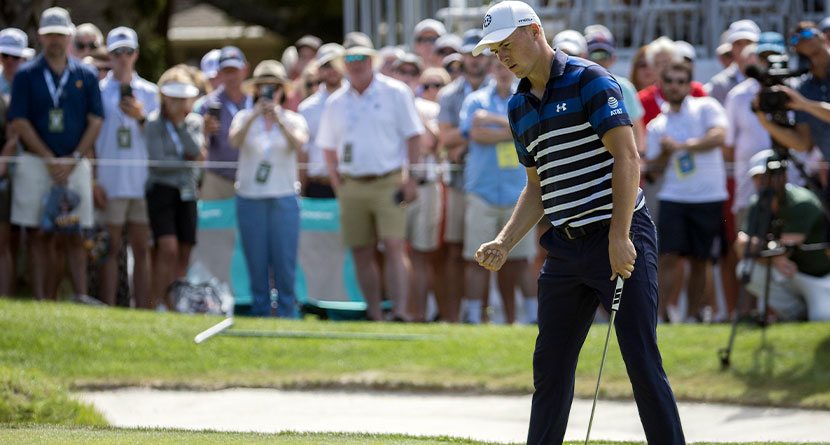I have been in the business of golf analytics and strokes gained since 1989, helping golfers at all levels to understand the strengths and weaknesses in their games.
I have worked with dozens of PGA Tour players, but I am most proud of my 13-year relationship with Zach Johnson which began in 2011 when I recommended to Zach’s coach, Mike Bender, that the Tour’s recently-launched Strokes Gained: Putting would be the best measurement of Zach’s putting.
I have never had the pleasure of working with Jordan Spieth, but like most avid golf fans, I have admired his game, personality and spirit. Next of course to Zach, Jordan is my favorite player on Tour.
Along with the joy that he exudes on and off the course, I have always believed that he was among the best putters ever to play the game, if not the best. Accordingly, I was surprised that his Strokes Gained: Putting ranking in 2015 was only 9th best on Tour.
How could that be?
Overall, he was No. 1 in the world that year with FIVE victories, including two majors (The Masters and U.S. Open) and The Tour Championship. Had those two majors been included in ShotLink, I know that his putting would have ranked higher, and likely No. 1.
Curious to know exactly what made Jordan such a good putter, I had a Distance Control study programmed to apply to the raw ShotLink data. This hypothesis proved to be the difference. The bottom line is this: while Jordan excelled at all distances, his greatest differential over his peers was his distance control on “lag” putts from 20 feet and greater.
Coincidently, I received a call from Jamie Diaz, a formidable golf writer for Golf Digest, asking if I could provide any insights into Jordan’s putting for an upcoming article by the editor, Mike O’Malley. I sent him my Distance Control study and he was kind enough to print it as a standalone article in the March 2016 issue.
In this study, I compared Jordan’s distance control in five measures from all putts of 20 feet and longer to:
- The 2015 PGA Tour
- The #1 ranked Strokes Gained putters for the most recent 5 years
- 2015 – Aaron Baddeley
- 2014 – Greame McDowell
- 2013 – Greg Chalmers
- 2012 – Brandt Snedeker
- 2011 – Luke Donald
It was no surprise that Jordan was remarkably better in each of my five measures than the 2015 Tour Average, but the fact that he was better than the averages of the five No. 1 SG: Putting players confirmed his excellence in this important skill.
As mentioned above, Jordan’s Strokes Gained: Putting rank was No. 9 in 2015, picking up +0.571 strokes on the field per round.
Fast forward to the modern day, I was shocked to see that has tumbled to No. 155 in 2022, giving back -0.207 shots to the field – a difference of .778 strokes per round. In 68 rounds, that amounts to 53 strokes – EXPENSIVE! A testimony to Jordan’s overall game, his scoring average for the two years studied only dropped by 0.43 strokes (only 55% of the strokes lost to putting alone).
I determined that 53% of the 53 strokes he lost were in the 20 feet+ range, while only 24% and 23% were attributed to the short range (1-10 ft.) and mid-range (11-19 ft.) respectively.
Let’s see what changed in Jordan’s outstanding distance control from 2015 to 2022. Here are the five measures that I have determined highlight this important skill:
- PERCENT 1-PUTTS
Jordan made less than half of these putts, albeit from a slightly longer distance.

- PERCENT 3-PUTTS (or 4+ putts)
Jordan had no 4+ putts, but again, from a slightly longer range almost doubled his 3-Putt total.

- SUCCESFUL LAGS (to within 7% of start distance or 3 feet)
Not a dramatic decline here and still better than the Tour average.

- PUTTS HOLED OR HIT PAST THE HOLE
Jordan’s ability to give the ball a chance to go in while still securing the 2-Putt was a key to his success in 2015. This decline obviously resulted in fewer 1-Putts and more 3-Putts.

- ERRORS (leaves of greater than 10% of start distance and outside 3 feet)
While the increase is not dramatic, the combination of longer leave distances makes it concerning. 68% of all the 3-Putts in the 20+ foot range in 2022 Tour resulted from these Lag Errors.

The good news is that thus far in 2023 Jordan has worked his way into a positive Strokes Gained position. His recent Valspar, Masters and RBC Heritage performances were excellent and improved his SG: Putting rank to 58th – a very positive trend.
Over the years that I have been studying distance control, the average Tour result from these important “lag” distances remains 7% of the original distance, ie. inside 2.1 feet for a putt of 30 feet.
For the rest of us mere mortals, I recommend that we aim for on a slightly larger target circle of 10% of the total distance of the putt, ie. inside 3 feet for a 30-footer. And I have two good reasons why: 1. We are obviously not PGA Tour-caliber players and 2. The math is so much easier.




